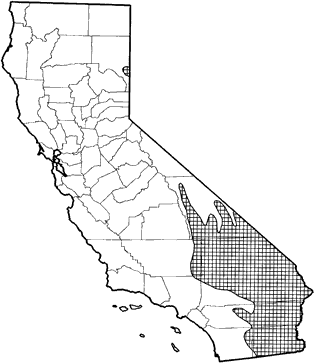
Desert Kangaroo Rat
Distribution, Abundance, and Seasonality
In California, discontinuously distributed in the southeastern part of the state. Locally abundant. Occurs north to Olancha and Keeler, Inyo Co., and west to Palmdale, Los Angeles Co., Hesperia, San Bernardino Co., and Borrego Springs, San Diego Co. Found in a variety of desert scrub habitats, the common factor being a substrate of wind-drifted sand, probably not less than 50 cm (20 in) deep (Hall 1946). Preferred canopy is sparse to moderate. Less common in denser stands.

Range Map
Specific Habitat Requirements
Feeding: Cheek pouch contents have included the seeds and heads of Glyptopleura; the seeds of Lupinus, Gilia, Larrea, and Artemisia; and plant parts of Atriplex and Penstemon (Hall 1946). Brown and Lieberman (1973) found that D. deserti, in southern Arizona, selected seeds that averaged 45 mm (0.16-0.20 in) in diameter. Most foraging is done between shrubs. Olfaction and surface cues appear to be important to kangaroo rats searching for subsurface seed caches.
Cover: Burrows are excavated at bases of shrubs or in soil banks in wind-drifted sand. There may be 6-12 entrances, about 10 cm (4 in) in diameter, which are plugged with sand during the day. Burrows seldom deeper than 60 cm (24 in) (Hall 1946, Miller and Stebbins 1964).
Reproduction: Nesting takes place in the burrow.
Water: Water is obtained from metabolism of food and from moisture in food.
Pattern: Sparse desert scrub with deep wind-drifted sand.
Species Life History
Activity Patterns: Active year-round. Crepuscular and nocturnal.
Seasonal Movements / Migration: None.
Home Range: Grinnell (1937) reported a density of 3.2 individuals per 40 ha (100 ac) in Death Valley.
Territory: No data found.
Reproduction: Young usually born March through June. Breeding occurs in the first yr following birth, although both males and females may, under the best of conditions, breed several mo after birth (Haley 1964). The gestation period is 29-32 days (Butterworth 1961). An average of 4 young born to each female, ranging from 3-5 (Hall 1946). Weaning is from 3-4 wk following birth. Life span under natural conditions probably averages 3-5 yr.
Niche: D. deserti is one of the largest of California's kangaroo rats. In field and lab trials, shown to be dominant over other Dipodomys and Perognathus. Predators include coyotes, foxes, badgers, snakes, owls.
Sources & References
California Department of Fish and Game, 1999.
California's Wildlife, Sacramento, CA.
Written by: P. Brylski, reviewed by: H. Shellhammer, edited by: R. Duke
Beatley, J. C. 1976a. Environments of kangaroo rats (Dipodomys) and effects of environmental change on populations in southern Nevada. J. Mammal. 57:67-93. Beatley, J. C. 1976b. Rainfall and fluctuating plant populations in relation to distributions and numbers of desert rodents in southern Nevada. Oecologia (Berlin) 24:21-42. Brown, J. H., and G. A. Lieberman. 1973. Resources utilization and coexistence of seed eating desert rodents in sand dune habitats. Ecology 54:788-797. Butterworth, B. B. 1961. The breeding of Dipodomys deserti in the laboratory. J. Mammal. 42:413-414. Grinnell, J. 1937. Mammals of Death Valley. Proc. Calif. Acad. Sci. 23:115-169. Hall, E. R. 1946. Mammals of Nevada. Univ. California Press, Berkeley. 710pp. Haley, J. J. 1964. Experimental usefullness of the kangaroo rat. Lab. Anim. Care 14:95- 102. Miller, A. H., and R. C. Stebbins. 1964. The lives of desert animals in Joshua Tree National Monument. Univ. California Press, Berkeley. 452pp.
California Animal Facts | California's Wildlife